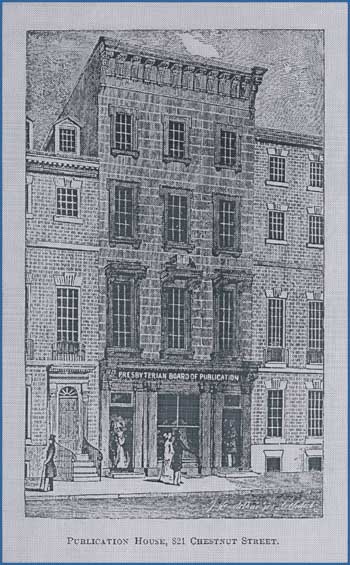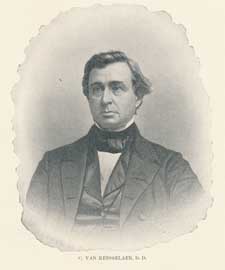 While THIS DAY IN PRESBYTERIAN HISTORY is sponsored by the PCA Historical Center, we have from the start taken a wider scope in the subjects covered here, not limiting ourselves to just the denomination known as the Presbyterian Church in America. The larger history of American Presbyterianism provides the context for our own specific story. Then too, while we could limit ourselves just to PCA subjects, our denomination is very much a conglomeration of churches drawn from nearly every other American Presbyterian denomination, and so it seems fitting to draw on the wider history of American Presbyterianism. Lastly, as Christians, it seems appropriate to lay claim to the history of other believers in our tradition—to find opportunities to praise God for the efforts of men and women of an earlier time who called Jesus their Lord and Savior, who faithfully served in His kingdom, and who were also known as Presbyterians.
While THIS DAY IN PRESBYTERIAN HISTORY is sponsored by the PCA Historical Center, we have from the start taken a wider scope in the subjects covered here, not limiting ourselves to just the denomination known as the Presbyterian Church in America. The larger history of American Presbyterianism provides the context for our own specific story. Then too, while we could limit ourselves just to PCA subjects, our denomination is very much a conglomeration of churches drawn from nearly every other American Presbyterian denomination, and so it seems fitting to draw on the wider history of American Presbyterianism. Lastly, as Christians, it seems appropriate to lay claim to the history of other believers in our tradition—to find opportunities to praise God for the efforts of men and women of an earlier time who called Jesus their Lord and Savior, who faithfully served in His kingdom, and who were also known as Presbyterians.
In that light, we turn our attention to today’s story. Presbyterians have alway placed a high value on an educated ministry, and so too have placed great emphasis on education in the Church. In turn, this leads to the need for a means to publish, to provide the tools of education, not to mention literature for evangelism, the publication of confessional Standards and the various documents of church government.
In the early years of the United States, the American Tract Society fulfilled some of these needs for a number of Protestant denominations. But with a concern to maintain doctrinal standards, many in the Presbyterian Church in the United States of America began to call for the Church to have its own means of publication. The first Board of Managers to oversee these publications met late in 1833, with the Reverends Ashbel Green, William M. Engles and Dr. A.W. Mitchell among those serving in this capacity.
Tracts formed the core of their early efforts, with the first four tracts (treatises, really) issued in 1835. Dr. Samuel Miller’s book-length work, Presbyterianism the Truly Primitive and Apostolical Constitution of the Church of Christ was issued as Tract no. 1. A printing of the Westminster Shorter Catechism was issued as the fifth “tract.” With further growth of the Board and its work, by 1838 the effort was expanded and the Board of Managers matured into the Board of Publication of the Presbyterian Church in the U.S.A. In time, greater funding allowed further expansion of the work, until at last the ministry outgrew rented space and needed its own home.
In 1848, a property on Chestnut Street in Philadelphia was located and purchased at a good price. But their new home had only been occupried for just a few months when, on January 6, 1849, the entire building was destroyed by fire. Insurance covered some of the loss, with support from churches and generous donors making up the rest. The building was rebuilt both larger and better, and the work went on. In fact, other aspects of the young denomination’s work also found a home there—the newly founded Presbyterian Historical Society, organized in 1852, being one such tenant.
Words to Live By:
Our Lord has promised that the gates of hell will not prevail against His Church. But that truth does not mean that a given ministry or agency of a denomination is for all time. The Church of Jesus Christ will go on until His return, but denominations and their agencies change over time. Some become corrupt and hollow. Some disappear altogether, while still others by God’s grace continue to hold fast to the proclamation of the Gospel. Our faith rests not in any denomination, its agencies, or its ministers. Our faith and trust can only rest on the Person of Jesus Christ, our Lord and Savior, and His finished work upon the cross. To God, and to God alone be all glory.
Image source: Above right, an engraved rendering of the Presbyterian Board of Publication building at 821 Chestnut Street, Philadelphia, as found facing page 20 in Willard M. Rice’s work, History of the Presbyterian Board of Publication and Sabbath-School Work. (1888).
Where Are We Now?
To eliminate any confusion, we should note that the publication arm of the old Southern Presbyterian Church was known as the Presbyterian Committee of Publication. So, to distinguish the old North from the old South, it was “Board” for the Northern Presbyterians (PCUSA) and “Committee” for the Southern Presbyterians (PCUS).
Looking at some of the NAPARC denominations, the PCA’s primary publication agency was known as Christian Education and Publication, but has more recently been renamed as the Committee on Discipleship Ministries (CDM). Their stated mission is “to assist leaders in the local church as they make disciples (Matthew 28:19) among children, youth, and adults in the congregation. In 2014, the PCA General Assembly changed our name from Christian Education and Publications (CEP) to reflect better the broad nature of the ministry of discipleship in the local church. We seek to help by connecting people to people and people to resources. We do this through consultation, training events, conferences, and resources available on the website. Our hope is that God will use the ministry of CDM to help PCA members experience the great blessings of a connectional church as we seek to partner together to fulfill the Great Commission.”
[We note that the PCA Bookstore still retains the “cep” lettering in its URL address: https://www.cepbookstore.com]
In the OPC, it’s The Committee on Christian Education of the Orthodox Presbyterian Church that oversees publications, and their ministry statement is as follows: “The Committee on Christian Education seeks to encourage, equip and assist the OPC by providing Reformed resources and training to help OP members grow in grace, aid ministers in effectively fulfilling their calling, enable officers to wisely serve the church, aid in biblically Reformed evangelism, and instruct those in the broader church.” [The OPC’s Committee for the Historian also publishes a number of titles].
For the RPCNA, their Board of Education and Publication “uses the media of print and music to promote, encourage, and defend the Reformed faith and testimony of the denomination. Publications include the Reformed Presbyterian Witness, a monthly denominational magazine, and other praise and testimony materials, including The Book of Psalms for Singing, Bible studies, pamphlets, and recordings. The Board also provides resources to assist presbyteries and congregations in their educational, youth, and conference programs. The publishing and distribution arm of the Board is called Crown & Covenant Publications.”
In the Associate Reformed Presbyterian Church, their primary publications are handled as a ministry of their Central Services agency, while their Board of Christian Education Ministries operates the ARP Bookstore and publishes Adult Quarterly Sunday school curriculum materials, as well as sponsoring retreats and other activities.
And finally, we should also mention the joint effort of the OPC and PCA, known as Great Commission Publications, which is concerned with publishing curriculum and worship materials. GCP is perhaps best known as publisher of The Trinity Hymnal.

